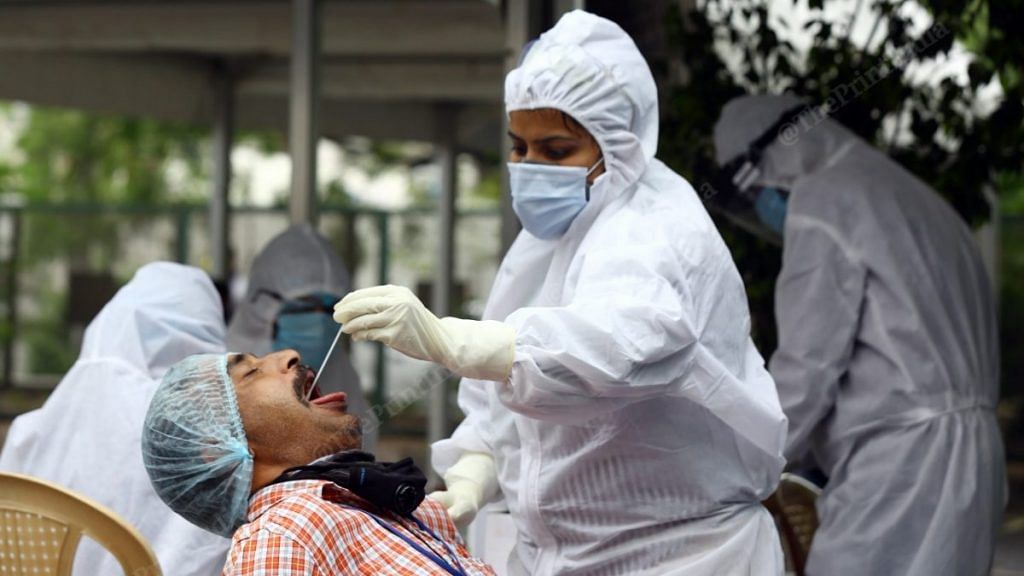New Delhi: India has recorded the highest single-day spurt in the number of Covid-19 cases and deaths so far, with 3,900 fresh infections and 195 fatalities reported in the past 24 hours, the Union health ministry said Tuesday.
Experts, however, said India’s positivity rate, which is the share of confirmed cases as compared to the number of tests conducted, has not changed much since the first week of the Covid-19 lockdown. The surge in numbers, they said, was due to more testing, more reporting and better contact-tracing.
The ministry’s announcement came just a day after the central government eased the lockdown, and the country saw a sharp spurt in its recovery rate. Speaking about the new figures at a press briefing, Lav Agarwal, Joint Secretary, Health, said it “is the highest increase noted in the number of cases and deaths” in 24 hours.
Over the last four days, India’s Covid-19 case count has seen single-day increases of at least 2,000. As of Tuesday morning, the total number of cases stood at 46,433, of which 32,138 are active cases. So far, the disease has killed 1,568 people.
Agarwal also suggested the rise could be attributed to the fact that India is conducting more tests than it did in the early days of the pandemic.
The 3,900 positive diagnoses were among 84,713 test results released by the Indian Council of Medical Research (ICMR) over the past 24 hours.
“If you see that the base of cases is lower, then automatically the next day… the number of cases will be lesser.. It is important to understand that we need to come to a level where day-to-day case increase should not be happening in a geometric progression. It should be happening in such a manner… (that) the number of cases which do get added are lesser,” he said.
Asked about the increase in the number of deaths, Agarwal added, “In one or two locations, larger cases of deaths have been reported. That is the primary reason why there has been a larger number of deaths.”
“We are dealing with an infectious disease, which is why the timely reporting of cases and their management is very crucial,” Agarwal said. “In some states, this gap was noted, which is why, after due persuasion, it’s being pursued.”
On Monday, the inter-ministerial central team sent to West Bengal (IMCT, among 20 sent across the country to assess the ground situation) censured the Mamata Banerjee government over alleged discrepancies in data.
In a letter to Chief Minister Mamata Banerjee, the IMCT said the mortality rate in Bengal was the highest in India, adding that it was a result of “low testing, weak surveillance and tracking”.
Also Read: Not just India, these 12 countries also eased their Covid-19 restrictions on Monday
Positivity rate the same
The positivity rate, which is the share of confirmed cases as compared to the number of tests conducted, has not changed much since the first week of the Covid-19 lockdown. It was recorded at 3.8 per cent on 4 May, the same as the rate on 1 April, when India had 1,837 cases.
“The surge in numbers is definitely because we are testing more and reporting more and doing better contact-tracing,” said Dr Tanmay Mahapatra, an epidemiologist working with CARE India, a non-profit that is supporting Bihar in its Covid-19 effort.
However, he added that most modelling studies done by epidemiologists had predicted a surge as India had had “sub-exponential growth moving towards exponential growth”. Exponential growth is when the cases increase rapidly with time.
“We have to now be careful about where the new cases are coming from and to monitor these areas, especially since the lockdown has been relaxed,” Mahapatra said.
‘Promote Aarogya Setu’
Union health minister Dr Harsh Vardhan Tuesday held the 14th meeting of the empowered group of ministers overseeing the government’s efforts to tackle Covid-19. The subjects discussed included the availability of personal protective equipment (PPE), masks, ventilators, drugs and other equipment required in the fight against the coronavirus pandemic.
“To facilitate risk assessment and to provide people with timely alerts, with the help of technology, it was decided that the Aarogya Setu app should be promoted,” Agarwal said at the press briefing, referring to the government app meant to allow users to detect Covid-19 patients in their vicinity.
A press release issued by the Press Information Bureau after the briefing said close to 9 crore users had downloaded the app as of 4 May.
“Dr Harsh Vardhan stated that the use of technology is integral for the containment strategy and is helping the states to manage the COVID-19 in a more effective manner,” the press release read.
Meanwhile, the health ministry has issued additional guidelines on the “rational use of personal protective equipment” by health workers. Agarwal said the guidelines specifically pertain to the use of PPE in non-Covid hospitals and the non-Covid treatment areas of a Covid hospital.
The advisory lists different combinations for the use of PPE such as masks, gloves, goggles and face shields, based on a health worker’s exposure to risk.
In another set of guidelines issued 24 March, the health ministry had only stated that the use of PPE in non-Covid treatment areas should be “as per hospital infection prevention control practices”. The advisory comes days after several non-Covid facilities across cities like Mumbai and Kolkata were closed down after patients and staff members tested positive.
Inputs from Swagata Yadavar
Also Read: As throng of tipplers shuts down Delhi liquor shops, some wait on, others keep stopping by
